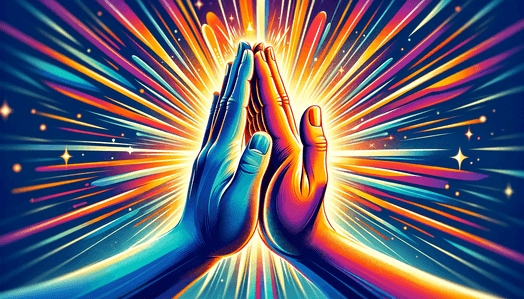Selecting the Perfect Color for Your Logo: A Comprehensive Guide
Discover the art of choosing the perfect logo color to leave a lasting impression on your audience.

Explore the profound impact of logo colors on brand perception and find your roadmap to logo success.
Picking the perfect color for your logo can be a daunting task. The choice of a logo holds significant importance as it serves as the initial impression of your business.
The right logo color can wield a profound influence on how your brand is perceived. Astonishingly, it takes just 50 milliseconds (0.05 seconds) for individuals to form an opinion about your brand solely based on your logo. Consequently, crafting a logo that truly stands out is of paramount importance.
In the world of branding, the significance of logo colors cannot be overstated. Understanding the nuances of each color and their impact on your brand's perception is crucial. So, let's embark on this journey of selecting the ideal logo color that will resonate with your audience across the globe.
The Profound Influence of Logos on Brands
Logos serve as powerful representations of your brand, communicating your message without uttering a word. Your chosen logo should possess instant recognizability among your clientele. The most iconic logos, renowned worldwide, share common characteristics:
Simplicity: They feature elegant simplicity in design.
Color Harmony: They utilize seamlessly harmonizing colors.
Strategic Color Usage: Colors are thoughtfully and strategically employed.
While mastering the “right way” to employ color may seem daunting, it's a manageable endeavor. In logo design, various principles exist, but there's no universally applicable template. If such a template existed, we'd see golden arches adorning everything.
This comprehensive guide aims to demystify color theory in the business context. With an understanding of color meanings, you'll craft your brand's narrative for maximum impact.
The Impact of Logo Color on Brand Perception
Color psychology delves into hues and their profound influence on human behavior, a fundamental pillar of branding and marketing. Logo design lacks off-the-shelf solutions; a color resonates differently for each brand.
The Palette of Prominent Logo Colors
Let's explore color preferences among the world's largest brands:
Blue: Preferred by 33% of brands.
Red: Chosen by 29%.
Black, Grey, Silver: Selected by 28%.
Yellow, Gold: Embraced by 13%.
However, blue's prevalence doesn't imply superiority. It prompts questions like: What emotions does blue evoke? Why do brands use it? What about red?
If you're pondering the meaning behind blue, worry not; we'll delve into that shortly. Consider this a reconnaissance phase—an essential step toward becoming a logo color connoisseur.
Utilization of Color in Logos by Most Brands
Most logos incorporate two colors; about 95% use a two-color palette, with only 5% opting for three or more.
Exemplary Combinations from Renowned Brands:
Facebook: Blue and White
Ikea: Blue and Yellow
Colgate: Red and White
FedEx: Purple and Orange
Starbucks: Green and White
McDonald's: Yellow and Red
Coca-Cola: Red and White
While some brands use more than three colors, Google employs blue, red, yellow, and green for a rainbow-inspired effect. Simplicity is advisable; limit your logo to two or three colors at most to prevent clutter.
Nuances of Every Color
Every color carries a spectrum of positive and negative connotations. It's essential to acknowledge that logo design is an art form, and art is inherently subjective. While some may find solace in the color blue due to its resemblance to the ocean, others with thalassophobia could perceive it as unsettling.
In reality, there's no universally cherished color. Preferences are subjective. What truly matters is that your logo resonates with your target audience. Despite the arduous, resource-intensive, and costly nature of logo creation, rushing it can be a costly mistake. After brainstorming, investing time in testing your logo's resonance with your target customers is imperative.
Building the Ultimate Instagram Presence for Your Ecommerce Brand | Part One
Your Comprehensive Guide to Logo Color Meanings
To determine the perfect color palette for your brand logo, delve into the meaning behind each hue. Explore the psychology associated with each color to gain a deeper understanding. This compilation covers the colors most frequently used in brand logos, helping you decipher the emotions and associations they evoke. This way, you can pinpoint ideal logo color combinations for your design process.
White Logos
White is often associated with cleanliness, peace, hygiene, simplicity, and sincerity. However, its interpretation can shift based on cultural values. In some regions, white symbolizes weddings (popularized by Queen Victoria), while in others, it signifies burials and mourning. If you choose white for your logo, consider your target customer base and how cultural perspectives may influence their perception of the color.
White also serves as a contrasting element in logos, creating negative space or complementing surrounding colors. FedEx, for example, cleverly uses white to form a subtle “arrow” within the negative space between two letters. Can you spot it?
Silver Logos
Silver embodies sleekness, affluence, grace, and elegance. When integrated into a logo, silver aptly conveys sophistication, industrial prowess, and technological advancement. While some jewelry brands once featured silver in their logos, its association has evolved toward industrial metals.
Incorporating silver accents in your logo underscores the refinement and upscale facet of your brand. Automobile brands like Toyota, Mercedes-Benz, Honda, and Citroen use silver, aligning with their high-end products. Silver is also common among video gaming brands, hinting at themes of weaponry and warfare.
Yellow/Gold Logos
Yellow evokes optimism, happiness, and motivation, while gold symbolizes opulence, grandeur, and wealth. Certain shades of gold exude wisdom, nobility, and allure. Gold's warmth radiates opulence.
It's vital to distinguish yellow from gold; pure yellow has a #FFFF00 code, while gold has #FFD700, with red or brown undertones. Gold graces luxury, financial, food, beauty, and fashion brand logos like Cadbury, Chevrolet, and Warner Bros. Yellow may suggest affordability, caution, or inexpensive products, as seen with brands like BestBuy.
Orange Logos
Orange exudes cheerfulness and enthusiasm. In logo design, it can be polarizing due to its high visibility. Peach-toned variations strike a balance between attention-grabbing and overwhelming. Orange suits entertainment (Nickelodeon, Soundcloud), food and beverage (Fanta, Dunkin Donuts), and dynamic brands (Firefox, Timberland).
Orange also carries religious associations in many Asian cultures, particularly in Buddhism and Hinduism.
Red Logos
Red universally symbolizes romance and can evoke various emotions, representing energy, passion, love, power, and seduction. Conversely, it can connote conflict, anger, war, and stress.
The connotations of red vary across cultures. It signifies romance and love for many, while in Asia, it's associated with weddings, symbolizing fortune and happiness. In certain African regions, red is linked to death and mourning.
Bright red logos are used to capture impulsive shoppers' attention, especially around events like Valentine's Day. Red is often paired with white, black, or neutral shades, popular among energetic and powerful brands. Restaurants, food brands, and sports teams, including Coca-Cola, frequently use red in their branding.
Pink Logos
Pink logos convey hope, inspiration, calmness, and comfort, often associated with childhood or whimsical aspects of life. In Japanese culture, pink represents spring and cherry blossoms. Pink is used in branding targeting a sweet or female-focused audience.
Millennial pink has gained popularity, signifying appeal to millennials, particularly women. Pink logos are relatively rare but can be found in baby brands, dessert businesses, and toy companies. Note that pink may imply immaturity or playfulness, which may not align with certain industries like tax accounting.
Green Logos
Green, the most soothing color for human eyes, universally represents relaxation, nature, peace, harmony, and wealth. It embodies tranquility and equilibrium and is associated with currency.
Green symbolizes the environment and eco-friendly products. Brands promoting vegetarianism, veganism, and sustainability often use green. The health food aisle in supermarkets showcases the prevalence of green branding in this space.
Blue Logos
Blue stands as the paramount choice among marketers and brands worldwide. It epitomizes tranquility, control, logic, honesty, intelligence, security, purity, freedom, and confidence. Its calming shades help establish trust-based relationships and lend a professional and serious aura to logos.
Blue is an obvious and safe bet for industries such as finance, IT, equipment, healthcare, energy, and transportation. Blue logos exude trustworthiness and professionalism, frequently employed by major corporations like Facebook, Twitter, Skype, Ford, Dell, IBM, Visa, and Samsung. Its positive associations work wonders in crafting a strong image for such enterprises.
However, in the wrong context, this primary color can come across as a tad cold and unfriendly. An intense aqua hue can verge on abrasiveness if not complemented with neutral elements, so caution should be exercised in its usage.
Violet/Purple Logos
Violet or purple, a color traditionally associated with royalty, luxury, and spirituality, evokes notions of creativity, extravagance, fantasy, sophistication, mystery, calm, luxury, high quality, and independence. Even a small dose of violet in a logo can infuse products with a sense of luxury, especially when paired with gold. Purple is particularly well-suited for packaging, making it a compelling choice for your brand palette. Consider Cadbury as an exemplary illustration—their purple hue instantly evokes feelings of opulence, nobility, and premium chocolate. Indeed, many chocolate brands opt for purple for this very reason.
Yet, like pink, violet remains an underutilized color in contemporary logo design. Few companies embrace it, but those that do often find a distinct niche. Think of brands like Yahoo, Taco Bell, Twitch, Wonka, Viber, and Benq.
Brown Logos
As the color of earth and wood, brown embodies practicality, stability, down-to-earth sensibilities, conservatism, and reliability. Brown provides support and comfort, symbolizing strength, maturity, and safety. It can even supplant green as a symbol of eco-awareness or organic products in certain contexts.
However, brown does have some negative associations, including dullness, cheapness, inactivity, depression, suffocation, rigidity, and associations with bodily waste. It may not be the best choice for leisure, finance, IT, or beauty brands.
Brown finds its niche in agriculture, food, transportation, and family products. Brands like M&M's, UGG, Paulig, Hershey's, and A&W have embraced brown to convey their values. UPS is perhaps the most prominent example of a brown-based logo, and the combination of gold and brown is iconic enough that they once ran a campaign with the tagline “What can brown do for you?”
Grey Logos
Grey is an intriguing choice for crafting a brand identity, exuding professionalism, conservatism, dignity, classicism, stability, and modesty. It imparts seriousness, professionalism, and credibility, ideal for lending startups gravitas. Grey's versatility allows it to convey diverse messages depending on accompanying colors, making it suitable for rebranding.
Traditionally, grey is used in finance, equipment, transportation, and IT sectors. While not common in food and beverage, Nestle and Grey Goose show that grey can work, breaking logo design conventions.
Grey's neutrality makes it a good starting point, though it can evoke feelings of melancholy or ordinariness. Its balanced sentiment complements lighter shades and tempers darker hues without starkness or clash.
Black Logos
Black embodies efficiency, sophistication, prestige, luxury, and authority. It exudes strength and seriousness but can also convey pessimism or coldness. It emphasizes the luxurious facet of a brand, catering to a select clientele.
Black is popular in luxury, fashion, IT, and equipment industries. Iconic logos like Adidas, Chanel, Nike, Dolce and Gabbana, and WWF feature black. However, it's associated with grief and mourning in many cultures, limiting its use in healthcare, baby care, food, and finance.
Choosing Your Logo Color
Now, decide on your brand's color, knowing it may evolve as your brand matures. Start with the basics for now.
Logo Colors for Industries
The interpretation of logo colors often varies by industry. Canva, a popular graphic design tool, provides an infographic outlining prevalent colors in different industries. Use it as a starting point and guideline.
We suggest starting with a black and white logo and gradually introducing one color at a time to find what works best for your brand. If the initial choice isn't effective, experiment with additional colors. Some brands use different logo versions based on context.
The Color Wheel
If you have a specific color in mind, consider using complementary colors to enhance its appeal. This may involve using a neutral background (black, white, or soft gray) or a vibrant accent color. DecoArt Blog offers infographics to assist with color selection, starting with the basic concept of the color wheel.
Complementary Colors
Complementary colors enhance each other. Find the complementary color for your chosen hue by looking at the color wheel opposite it. Complementary color combinations make your chosen color stand out. For example, green complements red, orange complements blue, and purple and green work harmoniously together.
You're absolutely right! The old Firefox logo is indeed a stellar example of the effective use of complementary colors in logo design. The juxtaposition of the fiery orange and cool blue creates a visually striking and harmonious contrast that captures attention and leaves a lasting impression. The combination of these vibrant colors not only complements each other but also conveys a sense of energy and excitement, making the logo both memorable and distinctive. It's a testament to how well-chosen complementary colors can enhance the impact and visual appeal of a logo.
Analogous Colors
An analogous color scheme involves combining three adjacent colors on the color wheel. The idea is to choose a “hero” color and incorporate the two neighboring colors. Analogous color schemes are less striking than complementary ones but can appear somewhat subdued.
Triadic Logos
Triadic logos consist of three colors from different positions on the color wheel, forming a triangular arrangement. They can be challenging due to the variety of colors involved but can make a strong statement when used effectively. For example, the bright red, yellow, and blue Superman logo is internationally recognized. Brands like 7/11 and Burger King also use triadic logos, with Burger King recently adopting a retro monochromatic style.
Monochromatic Logos
A “monochromatic” approach uses different shades of a single color, highlighting sophistication. PayPal and Oreo employ a monochromatic scheme, featuring navy blue and sky blue in their logos.
Ensuring Consistent Use of Logo Color and Branding Hues
After choosing your logo design, ensuring consistent branding is crucial. Each color has its CMYK and hex codes for print and web design. Whether you create the logo or hire a designer, obtaining these codes ensures brand consistency.
Ensuring Your Logo Color and Branding Hues Are Used Consistently
Once you've chosen a logo design that effectively communicates your brand's story, the next step is to ensure consistent branding. While pinpointing the exact shade on a color wheel can be challenging, there are strategies to consistently select the right color:
Utilize Color Codes: Each specific color has its own CMYK code for print materials and hex code for web-based design. Whether you create the logo
in-house or work with a graphic designer, obtaining these color codes is essential. They are invaluable tools for maintaining brand consistency across various platforms.
Logo Colors FAQs
How can I make my logo stand out from competitors using color?
Color can have a significant impact on your logo's visibility. Bold and vibrant colors can capture attention, while poorly chosen colors can deter potential customers. To differentiate yourself from competitors, consider using colors not commonly found in your industry. For example, if eco-friendly water bottle brands in your market typically use earth tones and greens, using bright reds and blues can create a distinctive contrast.
Should I incorporate my brand's color scheme into my logo design or start from scratch?
Ideally, your logo's color scheme should align with your brand's established colors for consistency. Starting from scratch may be necessary if your brand colors differ significantly from your logo.
Is it a good idea to change my logo's colors periodically to follow design trends?
Constantly changing logo colors to follow trends can be costly. It's advisable to prioritize other aspects of your business and focus on creating a timeless and enduring brand identity. Many major corporations have returned to their retro logos and colors, emphasizing the importance of a consistent and timeless brand image.

Benjamin Anderson
Share





